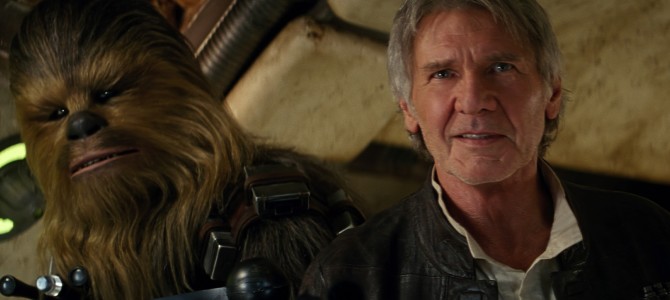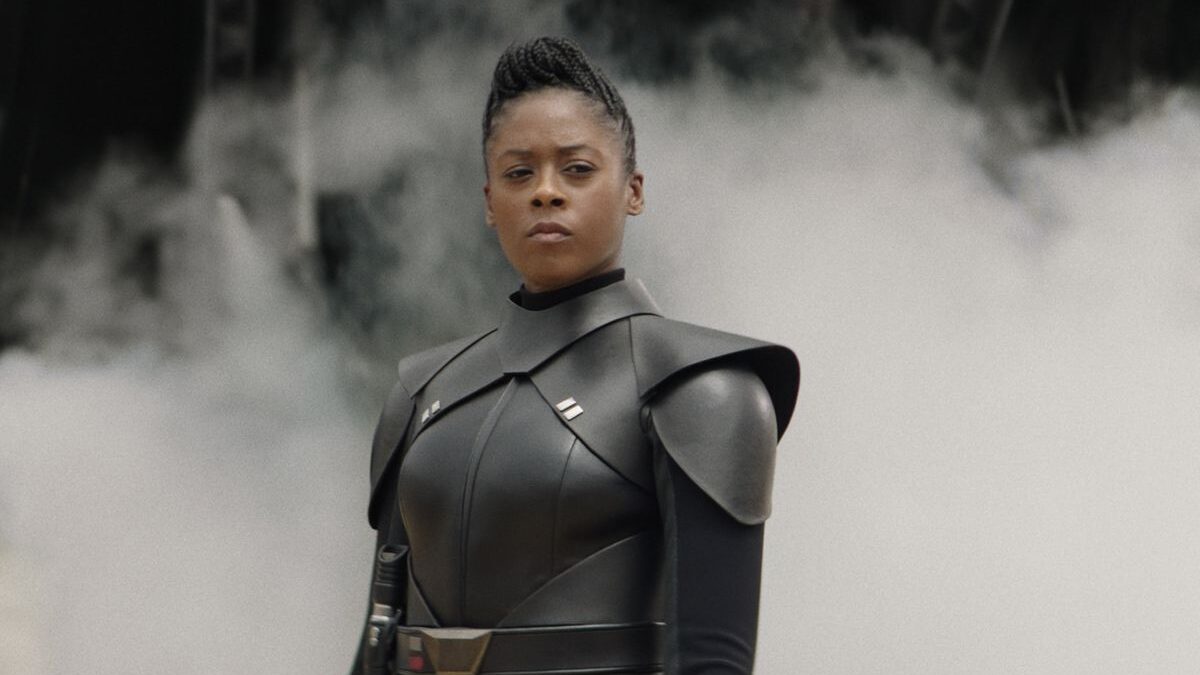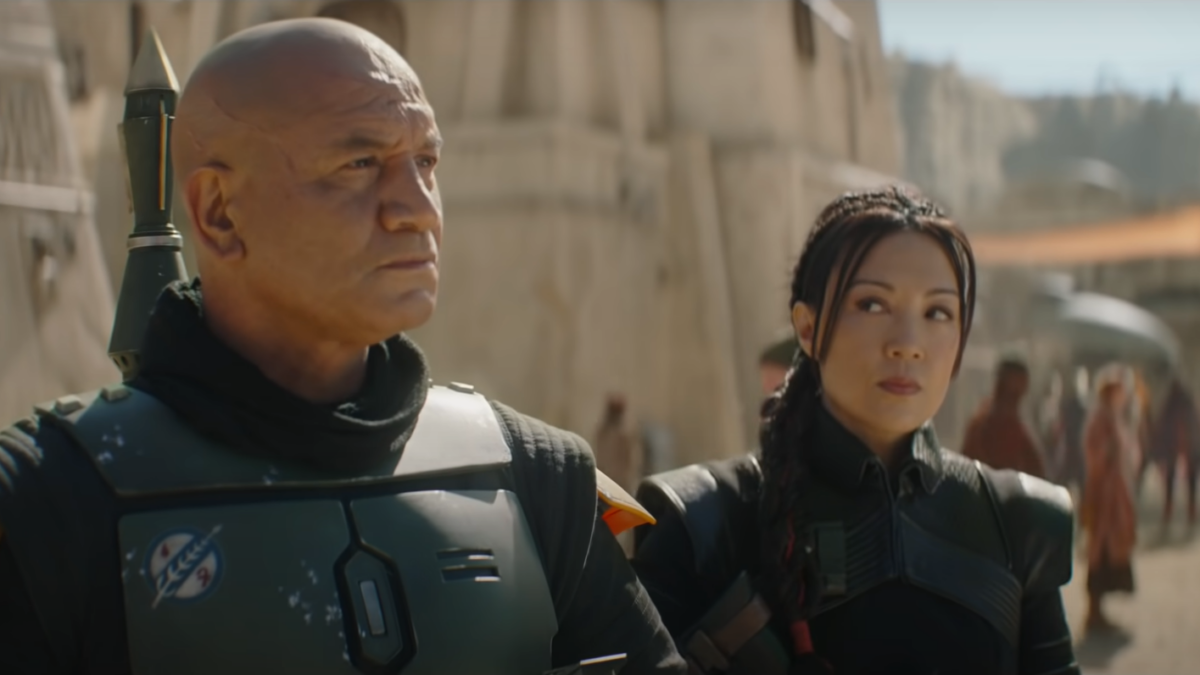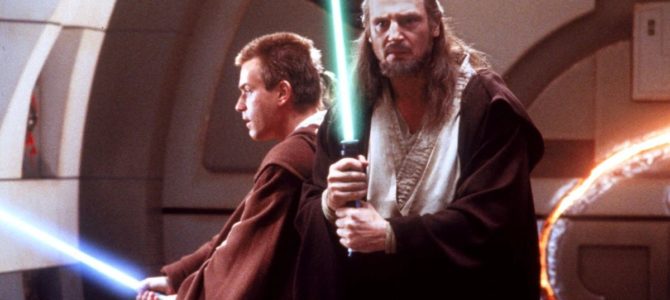
The words caused a disturbance in the Force, as though millions of voices suddenly cried out in triumph and were suddenly enraptured: “Chewie, we’re home.” The phrase, uttered by Harrison Ford at the end of the first full trailer for “The Force Awakens,” sent fans and media alike into an ecstatic frenzy upon its debut in April.
Those words have been the lodestar of Disney’s marketing campaign. “Star Wars fans,” the message has been, “you’re going home.” This message has been emphasized overtly and subtly for over a year. In a few days, the circle will be complete and the journey at an end. We will be home.
There’s just one problem: there’s no home to return to. It is impossible to go “home” again, because in the 38 years since “Star Wars” was released, the galaxy far, far away has changed in ways it was impossible to envision on May 25, 1977—even with the power of the Force.
Home Is a Ruin
Home isn’t just about seeing familiar faces in familiar surroundings, so the sight of actors from the original trilogy playing the same characters couldn’t by itself explain the reaction. The ecstasy, the awe, and the tears were not for what was on the screen but for what was in fans’ heads. The sight of Han and Chewie only clinched what the trailer had been hinting subliminally to fans for the previous two minutes: “This is Star Wars as you knew it, the Star Wars of your memories, the Star Wars of your childhood.”
Tania Gonzalez described how she “was flooded with memories” of her childhood and reminded of why she became a “lifelong” Star Wars fan. The trailer made her cry, she explained, “Because I got my heroes back, because I get to see what happens next and because I felt like an 8-year-old girl who was able to travel to a galaxy far, far away without leaving her couch.”
“In just two short minutes,” proclaimed Joe Neumaier in the New York Daily News, “director J.J. Abrams . . . tapped into everything we loved about the original trilogy from 1977-83.” The trailer as a whole, wrote Spencer Kornhaber in The Atlantic, “reminds of the originals in every frame.” Even the new elements, he noted, seem “extremely familiar.” Everything old, it would seem, is new again. But it is still old, and the trailer does nothing to disguise the fact. Indeed, it conveys another message, one that belies Harrison Ford’s hopeful words. “You may be home,” it whispers, “but home is a ruin.”
Consider the first shot of the trailer. It is a striking image. We see a star destroyer and an X-wing that crashed on the planet Jakku and have slowly been conquered by its sands. A speeder, noticeable because of the dust trail it raises, zooms by, destination unknown.

Or not so unknown. That speeder is headed the same place we all are: the future. To get there it is leaving the wreckage of the past behind. That’s just what the two wrecked ships are, the detritus of the past. The X-wing and star destroyer are two of the most iconic vessels of the original trilogy, and the first thing we see in the trailer is an image of them consumed by the ravages of time.
When the trailer was released, I was immediately struck by how strongly the scene embodies the aesthetic of seventeenth- and eighteenth-century paintings of classical ruins. There is the same tinge of decay, the same brownish-yellow patina of rust and oxidation, the same atmosphere of a past that is crumbling yet still with us as we see people going about their lives while the ruins loom over and around them. A few examples will illustrate what I mean.
First, Claude Lorrain’s 1634 painting, “Capriccio with Ruins of the Roman Forum.”
Next, a 1730 painting by Giovanni Paolo Panini, “Capriccio of Classical Ruins.”

Last, one more by Panini, “St Sibyl’s Sermon in Roman Ruins with the Statue of Apollo” (1740s).
But the image of the crashed X-wing and star destroyer isn’t the only one from the second trailer that suggests Star Wars as we knew it is defunct. An even more obvious one appears a little later in the shape of the melted, deformed mask of the hero of the first six movies, Darth Vader.
At the beginning of the third and final trailer for “The Force Awakens,” we see Daisy Ridley’s character, Rey, scavenging what looks to be the interior of one of the ruined ships seen in the second trailer. “Scavenging” is the appropriate metaphor for what Kathleen Kennedy, J. J. Abrams, Lawrence Kasdan, and company have done with Star Wars. They have mined the ruins to build out of them anew, recycling the old just as Europeans used the pillars of Roman civilization as quarries for centuries.
The Star Wars of your childhood still exists, but it’s a junkyard to be stripped for parts. Welcome home!
The Prequel Menace
There is, of course, one part of the Star Wars universe that many fans would gladly see consigned to the scrap heap—the prequels. The media consensus about the trailer was that if it was not a repudiation, it was certainly an apology for the three most recent Star Wars movies. It was crafted “like a lengthy love letter” to fans who haven’t stopped grousing since 1999.
The trailer demonstrated that director Abrams and screenwriter Kasdan “seem to know their job is to jettison the bad feelings left over from” the prequels. The sentiment was nearly universal. No wonder fans felt like they were coming home—after 30 years wandering in the wilderness, they had finally reached the promised land.
The promised land is just what Disney has promised. From the earliest days of production, it has vowed that the CGI of the prequels would be discarded for practical effects, miniatures, props, and live sets—the techniques of the originals. If the new films are made like the originals (and not the prequels), they’ll be like the originals (and not the prequels).
Whether that’s Disney’s actual thinking, such has been their message for the last year. If this seems like a carefully honed public relations strategy, that’s because it is. Disney is using nostalgia to sell Star Wars, and fans are buying. Many fans had convinced themselves that Star Wars needed to be rescued. The House of Mouse is telling them, first, that they are right and, second, that Mickey is here to rescue them. There are only two problems with this. It’s all lies, and plenty of fans believe Star Wars doesn’t need to be rescued at all.
The popular impression of the prequels is that they were all green screen, all computers, all fake. So entrenched is this opinion that Disney has felt obliged to work around it. But the idea that the prequels were nothing but CGI is nonsense. More miniatures were used on any one of the prequels than in all of the first three films combined. Models and practical effects are everywhere you look in the prequels.
Indeed, many of the effects prequel detractors dismiss for their obvious CG and green-screen origins are in reality physical props and sets. The prequels don’t look different from the originals, they don’t look shiny and new and sleek, because they were made artificially (as if the originals weren’t any less artificial). They look that way because they’re supposed to. That look took a massive amount of practical effects to achieve.
Here’s the secret: Disney is fully aware of this. They say nothing because it’s easier for them to placate the prejudices of fans, at least that vociferous contingent that has spent the last 16 years bleating about how George Lucas “raped” their childhoods, than it is to undertake the admittedly difficult task of repairing the prequels’ low esteem.
To borrow an analogy from politics, Disney is targeting the base. One might even say it is pandering. But here’s another secret: the prequels’ standing with fans is not nearly as dire or irredeemable as the conventional wisdom has it.
Star Wars Fans Comprise Warring Factions
The prequels have many admirers. They can tolerate the reflex to bash them; after 16 years they’re inured to it. What they cannot abide is seeing that reflex, if not encouraged, certainly not discouraged by the new custodians of Lucas’s progeny. Thus, when it seemed Disney was giving that reflex a quasi-official imprimatur at the San Diego Comic-Con in July when it unveiled a behind-the-scenes video emphasizing the “return-to-the-roots” filmmaking techniques it had spent the previous year publicizing, prequel fans did not hesitate to express their frustration.
Some were measured in their criticism, describing mostly with resignation how the Comic-Con panel validated their suspicions that Disney’s marketing campaign would be cleverly albeit cynically predicated on trashing the prequels to win back fans whose faith had lapsed over the years. Others, considerably less forgiving, accused Disney and Lucasfilm executives of “relegating the prequels to the crazy uncle attic” because they “live in mortal fear of the hateboys” and “keyboard barbarians.”
There is nothing wrong with wooing disaffected fans of the original trilogy. Disney would be committing malpractice if it didn’t. The prequel-bashing strategy, though, is the wrong way of going about it. For one thing, it is mendacious. The prequels were made using every practical effect in the book, and the movies Disney oversees will be suffused with computer effects—the characters played by Lupita Nyong’o and Andy Serkis in “The Force Awakens,” to name just two.
I suspect many fans know that they are being lied to. But they don’t care because it boosts their egos immeasurably to see the new masters of “Star Wars” flattering their chauvinism. Cynicism, deceit, prevarication—whatever the basis of Disney’s marketing, it is not one that redounds to Team Mickey’s credit.
One of the sources I quoted decrying Disney’s badmouthing of the prequels is a post from the website of the Star Wars Prequel Appreciation Society. Yes, such a thing exists. Judging by the number of aggrieved tweets that greeted the Comic-Con struggle session, it has numerous sympathizers.
Disney’s strategy of “throwing the prequels under the Sandcrawler” is worse than a crime. It is a mistake. It is a mistake because it fundamentally—and perhaps willfully—misunderstands the present state of Star Wars fandom and the prequels’ place therein. Most of all, it is a mistake because it isn’t 2005 anymore, let alone 1983.
The Star Wars Generation Gap
Sixteen years. That is how far “The Phantom Menace” was from “Return of the Jedi,” and that’s how far “The Force Awakens” is from “The Phantom Menace.” In that interval, an entire generation has grown up for whom the prequels and its offshoots are Star Wars. The original trilogy dominates the imagination because it dominates the conversation. (Or is it the other way around?) It came first and transformed popular culture. Its fans are legion and they are voluble.
But they are not the only fans, and whether they like it or not there exists now a generation whose members, when they went to see a Star Wars movie for the first time, saw a prequel. They played with prequel toys and dressed up as prequel characters for Halloween. From their perspective, the dogma that the prequels are ersatz is a non sequitur because for them Star Wars has always included the prequels. They’ve never known a Star Wars that didn’t.
Mallory Andrews, in an illuminating essay, pointed out how the cohort of fans whose experience of Star Wars culminated with “Revenge of the Sith” is not shy about professing their admiration for the film. But it isn’t only the last of the prequels whose praises one can hear now.
While no one’s been looking, the prequels have been undergoing a process of critical reappraisal. The revisionists, though they acknowledge the prequels’ flaws (far fewer in their estimation than their detractors maintain), are dedicated to highlighting what they consider to be their numerous virtues.
Two excellent examples of this trend, both of which approach the prequels from a theoretical perspective, are Mike Klimo’s “Star Wars ring theory” website and Paul McDonald’s book “The Star Wars Heresies” (2013). Other appreciative analyses of the prequels include the one penned by Anthony Parisi and Bob Clark’s two essays on “The Phantom Menace” and “Attack of the Clones.” The most percipient example of prequel revisionism might be the most recent, Roderick Heath’s subtle, exhaustive exegesis of the prequel trilogy. Effusive in their praise, all tread close to what traditionalists would probably regard as apostasy.
Disdain for the prequels is neither uniform nor unanimous. Why, then, would Disney risk alienating prequel fans by succoring those who persistently mock and deride them? As Andrews suggested in her essay, Star Wars fandom has become “bifurcated” between those who repudiate the prequels and those who don’t. If the release of “The Force Awakens” is to be the occasion for a reckoning between the two groups, the last thing Disney should want is to turn this bifurcation into a permanent schism, especially when the risk is that their marketing could cause another rift if those who embrace one or both of the first two trilogies wind up disliking the third.
Gonzalez, in the essay I cited earlier, described her relationship with the prequels this way: “Not having my heroes in the second trilogy was strange. It was hard to conceive of Star Wars without them. It wasn’t the same.” Doubtless she wasn’t the only one to feel this disconnect.
Given this, perhaps the wiser option for Lucas would have been to do sequels first, when original fans were still the main demographic, and then start anew two generations later and do the prequels now. That is, the prequel trilogy and sequel trilogy should have been reversed.
That path is closed now. Yet there is some indication Disney believes it may have been the better one to follow. The decision to wipe out the expanded universe is evidence of this. The only reason to do that is so that they can start fresh for new fans who don’t have that baggage; to create a tabula rasa, if you will. Hence, despite Disney’s disingenuous marketing, fears that the prequels will be jettisoned or erased are misplaced.
For one thing, despite the lip service paid to prequel haters, Disney knows it can’t afford to alienate prequel fans. But—and this is the crucial point—Disney’s chief concern is not those who are fans of either the prequel or original trilogies, but those who are fans of neither because they are not fans or because they don’t exist yet. For Disney, Star Wars is all about the future—and in the future present fans will play a progressively diminishing role.
Whose Star Wars?
I am a proverbial “fan since ’77,” part of that first generation of fans who had the good fortune to see Star Wars when it was just Star Wars, and not “A New Hope” or “Episode IV.” The generation of fans who saw at least one of the original trilogy in the theater has been followed by at least four more distinct cohorts of fans, defined by when they were first introduced to Star Wars: that of the post-“Jedi” fallow period, that of the Timothy Zahn/expanded universe period, that of the Special Editions and prequels, and that of the post-prequel and “Clone Wars” TV series era. We are about to meet the sixth generation of Star Wars fans. They are a long way removed from mine.
A five-year-old in 1977 is now 43. A 12-year-old is 50. And someone who had been in his late teens is pushing 60. I hate to break it to you, but Star Wars doesn’t belong to us anymore. Disney would love for us to love the new movies, but they won’t care if we don’t. It’s the new generation of fans that matters. (If you don’t believe it, just watch the introductory promotional videos that have aired on DisneyXD, Disney’s youth-oriented cable network.) This brings us to what is probably the most important issue of all: who is Star Wars for?
Germain Lussier averred in a recent post at io9 that “The Phantom Menace” doesn’t understand what a Star Wars movie is supposed to be. That “The Phantom Menace” diverges dramatically in tone and theme from its predecessors cannot be denied. But to declare that it doesn’t “get” Star Wars is to commit a category error.
Until he sold Star Wars to Disney, Star Wars was what Lucas said it was. He not only knew better than anyone what Star Wars is, no one else knew at all. “Star Wars,” according to Lussier, “is archetypes. Good vs. evil. Star Wars is adventure, excitement, characters, humor, swagger, amazing locations and more amazing creatures.” It is all those things, but they are and always have been secondary. Star Wars, first and last, narrates the saga of the Skywalker family. Everything else we see exists only to tell that story; it is not the story itself. What Lucas wanted it to be—that’s what Star Wars was.
Lucas, though, is no longer there. This raises an important question that has not received nearly the attention it deserves, largely, I think, because Star Wars fandom is still more than 12 parsecs from coming to terms with the legacy of its maker. That question, simply, is this: Is Star Wars without George Lucas still Star Wars?
Fans have been waiting a long time to find out. Now they are going to get their wish. Disney itself has equivocated, on the one hand succoring the anti-Lucas brigades, while on the other paving the way for Star Wars to start in some sense de novo. Fans who have soured on Lucas and want to see what others might do with his universe, though, should not be too proud of the technological terror Disney is constructing.
As Spencer Kornhaber wrote in April, the reliance on nostalgia to sell “The Force Awakens” in some sense betrays its creator’s vision. All six movies, Kornhaber noted, “showed you something completely bizarre and fabulous” that wasn’t in the previous movies. Having seen all six movies in the theater, I know the sensation of seeing a new Star Wars movie and feeling that everything is different yet somehow the same; that it’s Star Wars yet isn’t Star Wars.
One should feel a little culture shock at new sights and sounds. It should feel familiar, but not so familiar there is nothing new to experience. Take “The Empire Strikes Back.” Fans had waited three years to find out what happened after the Death Star blew up, and what they got instead is “Happy Fun Snow Time with Luke Skywalker.” It must have struck many fans in 1980 as utterly bizarre that the first 20 minutes of the film are all about Luke’s being lost in the snow. No one could blame them for wondering “What the hell is this?” Whatever it was, it was nothing like Star Wars. But no one remembers it that way now.
I expect a fair amount of culture shock the first time fans sit in the theater and see Cinderella Castle instead of the Fox searchlights. This, I think, will be the first time it really hits home that it’s no longer Star Wars as they knew it, that they have taken their first step into a larger world, willing or no. That’s the thing: Star Wars has always been changing, right from the moment Lucas altered its entire trajectory (at least from fans’ perspective) with Darth Vader’s epochal revelation at the conclusion of “Empire,” and by calling “Empire” “Episode V.”
“You can’t stop the change, any more than you can stop the suns from setting.” A lot of fans have been unhappy with the change. Disney has promised them redress. But there is no guarantee they will like what Disney does with Star Wars, either. Star Wars has already changed in ways fans didn’t like, and is likely to do so again. The biggest change, of course, is that Disney is now in charge. There is some reason to be skeptical.
What Disney Will Do to Star Wars
When Lucas was in charge, whatever one thought of his vision, it was his vision. Star Wars movies, moreover, were rare. They were an event. Star Wars was a franchise—it invented the concept—but it was a franchise apart. It was unique, it was special.
Will it be still be special once Disney cranks Star Wars movies out from an assembly line one per year? Star Wars will still be a franchise, but maybe not the franchise. It may become just another cog in Disney’s blockbuster machine, part of the genrefication of Hollywood. Are fans ready for the Marvelization of the galaxy far, far away? Is that really what they want?
Next Christmas we will get, for the first time, a Star Wars movie that is not about the Skywalkers. Disney had a whole galaxy’s worth of stories to tell. So of course it decided to make a prequel of its own and chose the theft of the plans for the first Death Star as the subject of its first spinoff. “Several transmissions were beamed to this ship by Rebel spies,” and now we’re going to find out how and who.
After Episode VIII in 2017, we’ll get another spinoff in 2018. Its subject: young Han Solo. And in 2020, maybe one about fan favorite Boba Fett. So far, Disney seems content (and intent) to plow the same furrow forever. Like the song goes, I look for a change but everywhere I go it all feels the same. It’s nostalgia, all the way down.
Being frozen in carbonite would be a disaster for Star Wars. It is the last thing fans should want. If Star Wars no longer changes, it will no longer be alive. It will become a Force ghost living on past glory. “In a higher world it is otherwise, but here below to live is to change, and to be perfect is to have changed often.” Star Wars is a long way from perfection.
We have been here before. The trailers for “The Phantom Menace” were greeted as rapturously as those for “The Force Awakens.” We know how that turned out. It might suck. Or, even worse, it might be just okay; a decent movie, but nothing special, certainly nothing that can requite boundless anticipation.
That’s why, I’m convinced, it behooves fans to temper their expectations. I don’t mean that they should diminish them to vanishing. I mean, rather, that they should attune their expectations to what it is possible for others to give them. What others can give can never match what one wills them to.
Star Wars is for everyone. But that also means it is for no one. Not me, not you, not him, not her. It exists to tell a rather simple story. Whatever else it is for, it is for that first and last. (One thing we can say definitively it isn’t for is to serve as a propaganda vehicle for anyone’s political agenda.)
This means there will be any number of things in the forthcoming films that fans will dislike for one reason or another. Fans were upset the prequels weren’t the movies they’d imagined in their heads for a decade. The sequels won’t be, either.
As a great sage put it, we must unlearn what we have learned. In we must go. We will find there only what we take with us: hopes, fears, memories. But one thing we won’t find is home. Home is gone.
In “Anthropology from a Pragmatic Point of View” (1798), Immanuel Kant discusses the homesickness of Swiss soldiers stationed away from their villages. When they return home years later “they are greatly disappointed in their expectations and thus also find their homesickness cured.” One reason is that their homes have changed so much in their absence. But another is that “they cannot bring back their youth there.” You can’t go home again. Home has changed—and so have you.
Come December 18, Star Wars fans from my generation will learn once more the verity of Joseph Priestley’s dictum, “The wisdom of one generation will ever be folly in the next.” Will they learn it this time?
Star Wars changed our lives once. It was never going to change it twice. That was too much to ask. What isn’t is to hope that the galaxy far, far away remains as exciting, bizarre, dramatic, alien, scary, awesome, and incredible as ever; that it is still as able to thrill us and delight our imaginations as it has been for the last 40 years; and that it will change the lives of a new generation of fans who will be seeing a Star Wars movie for the first time.
Most of all, we should hope that Star Wars still belongs to tomorrow. The future is always in motion. Wherever Star Wars leads us when the Force awakens, it should not be into the past.









